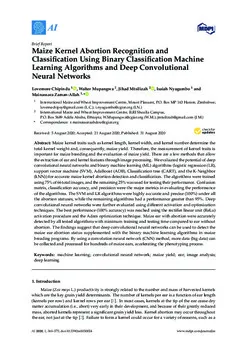Maize kernel abortion recognition and classification using binary classification machine learning algorithms and deep convolutional neural networks

Abstract
Maize kernel traits such as kernel length, kernel width, and kernel number determine the total kernel weight and, consequently, maize yield. Therefore, the measurement of kernel traits is important for maize breeding and the evaluation of maize yield. There are a few methods that allow the extraction of ear and kernel features through image processing. We evaluated the potential of deep convolutional neural networks and binary machine learning (ML) algorithms (logistic regression (LR), support vector machine (SVM), AdaBoost (ADB), Classification tree (CART), and the K-Neighbor (kNN)) for accurate maize kernel abortion detection and classification. The algorithms were trained using 75% of 66 total images, and the remaining 25% was used for testing their performance. Confusion matrix, classification accuracy, and precision were the major metrics in evaluating the performance of the algorithms. The SVM and LR algorithms were highly accurate and precise (100%) under all the abortion statuses, while the remaining algorithms had a performance greater than 95%. Deep convolutional neural networks were further evaluated using different activation and optimization techniques. The best performance (100% accuracy) was reached using the rectifier linear unit (ReLu) activation procedure and the Adam optimization technique. Maize ear with abortion were accurately detected by all tested algorithms with minimum training and testing time compared to ear without abortion. The findings suggest that deep convolutional neural networks can be used to detect the maize ear abortion status supplemented with the binary machine learning algorithms in maize breading programs. By using a convolution neural network (CNN) method, more data (big data) can be collected and processed for hundreds of maize ears, accelerating the phenotyping process.
